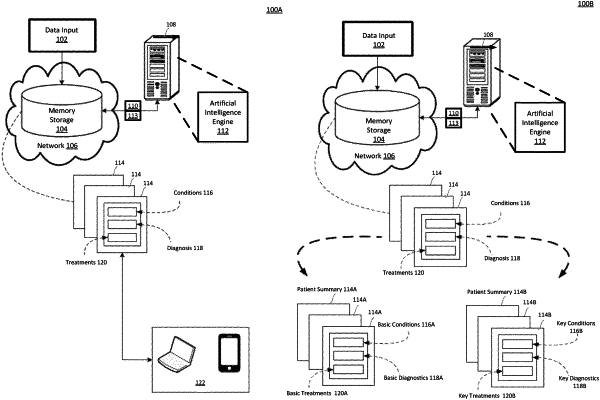| CPC G16H 15/00 (2018.01) | 17 Claims |

|
1. A system comprising:
a memory configured to store instructions for an artificial intelligence engine;
a processor coupled to the memory and configured to read the instructions from the memory to cause the system to perform operations, the operations comprising:
receiving, over a network, patient data associated with a patient, the patient data including unstructured data and structured data collected from multiple computing systems;
determining, using a plurality of natural language processing models in the artificial intelligence engine, each natural language processing model trained on historical data of multiple patients to identify a specific clinical issue, clinical issues of the patient from the unstructured data;
determining, using a knowledge graph, treatments associated with the clinical issues;
determining active diagnostic orders and active treatment orders from the structured data;
summarizing, using a plurality of natural language generation models, the clinical issues, the treatments, the active treatment orders, and the active diagnostic orders into a plurality of summaries, wherein each natural language generation model is trained to summarize a corresponding clinical issue, a treatment, a treatment order, or a diagnostic order based on the historical data;
receiving, at an aggregating natural language generation model, the plurality of summaries from the plurality of natural language generation models;
aggregating, using the aggregating natural language generation model, the plurality of summaries into an aggregate summary associated with the patient, wherein the aggregate summary is a paragraph and includes at least one hyperlink embedded into the paragraph, wherein the hyperlink is associated with at least one summary in the plurality of summaries and wherein the at least one hyperlink comprises additional information associated with the at least one summary;
receiving a message including a type of a user from a user device for displaying the aggregate summary;
associating the type of the user in the message with a hyperparameter;
smoothing, using the aggregating natural language generation model and the hyperparameter, the aggregate summary according to the type of the user included in the message, wherein a smoothed summary associated with a first user type is different from a smoothed summary associated with a second user type; and
transmitting the smoothed aggregate summary including the at least one hyperlink for display on the user device, wherein the at least one hyperlink expands the smoothed aggregate summary on a display screen of the user device upon receiving input at a location of the at least one hyperlink to display the additional information.
|